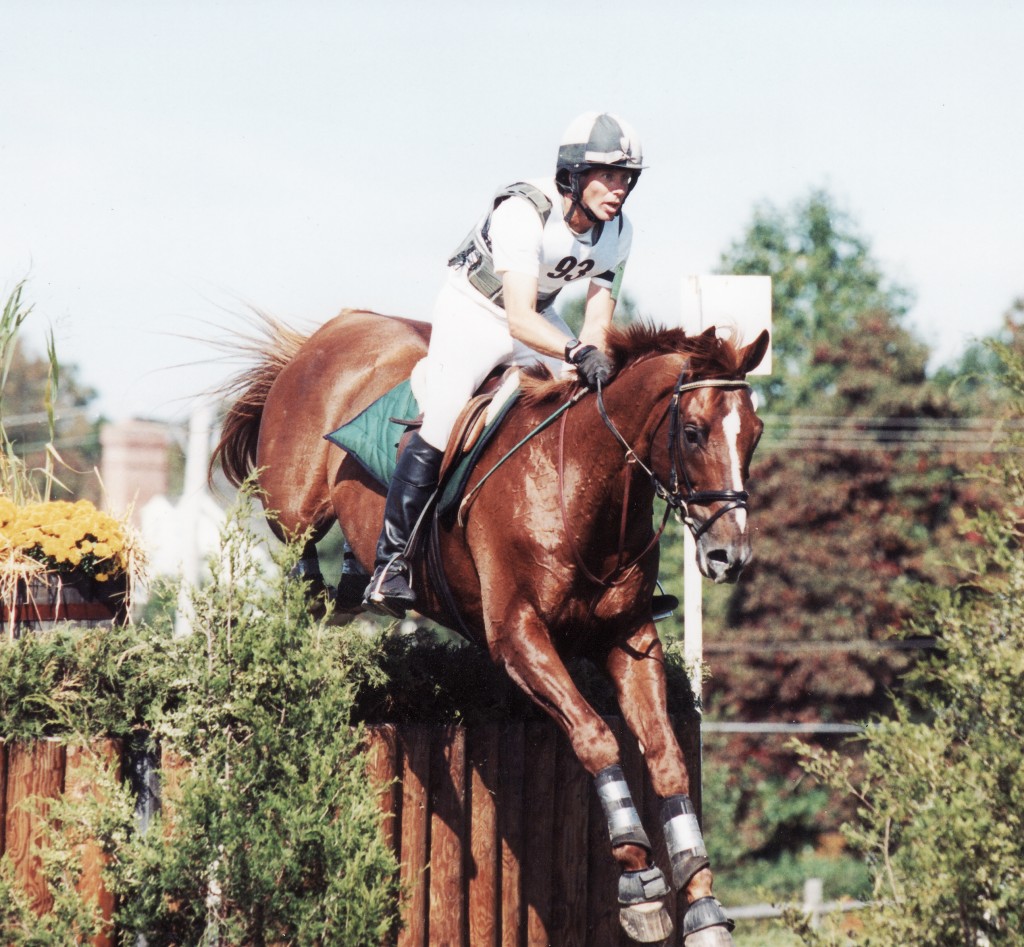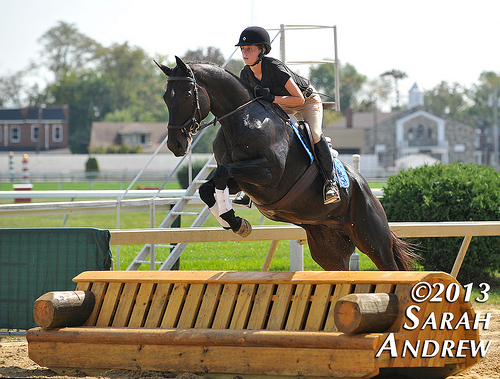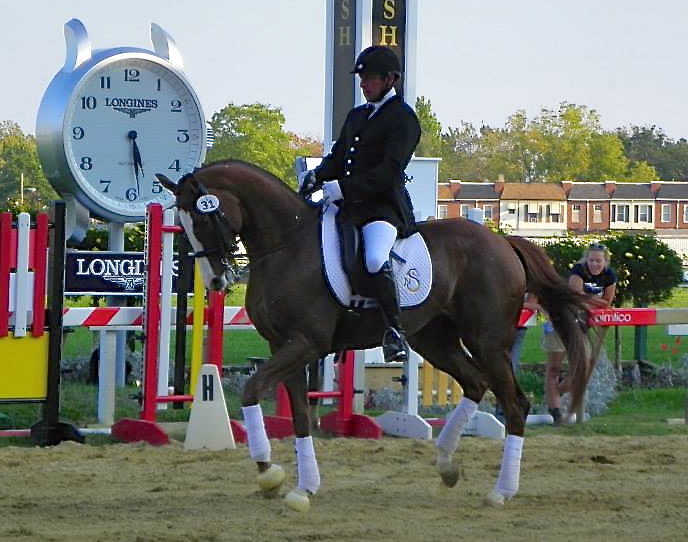
Steuart Pittman, founder of Retired Racehorse Training Project, and promoter of TB sport horses, says the market for off-track Thoroughbreds keeps getting better and better. Here Pittman rides Salute the Truth.
While some demos at the Maryland Horse World Expo went begging for an audience last month, the T’bred events packed them in like sardines.
“The breed is historically one of the most popular in America, not just because they’re loved, admired and beautiful but also because news of their talent as sport horses has really caught on,” says Steuart Pittman, creator of the popular Retired Racehorse Training Project.
In this week’s Clubhouse Q&A, Pittman discusses the growing reach of his ever-popular Thoroughbred retraining contests, which pit green horses and talented riders against each other, and the clock, to turn out a beautifully trained off-track Thoroughbred mere months after leaving the racetrack.
Pittman recently hosted packed seminars at the Maryland show, and is eagerly looking forward to more racehorse makeover success stories, as more and more people decide that their next horse will be an ex-racehorse.
Q: When it came time to introduce three well-trained Thoroughbred sport horses to a crowded arena, it was not seasoned riders who showed them to their best advantage.
What wound up happening was that after I invited participants who were in our show at Pimlico to join me in Maryland, the three who could make it were all teenage girls ages 14 and 15.
It was a nice surprise for people, and even though we’re very careful not to tell the public that anybody can go pick up a horse off the track, it does demonstrate that kids who are already riding, and are moving up from ponies, can actually do quite well on a Thoroughbred, enjoying the forwardness and athleticism of these horses.
Q: Who were these young ambassadors and their horses?

Elissa Ogburn demonstrates the skills she taught her OTTB Governor Jack at the Retired Racehorse Training Project’s event last fall at Pimlico. Photo courtesy Sarah Andrew
We had Elissa Ogburn who rode her horse Governor Jack, who is by Sky Mesa who stands at Three Chimneys. Governor Jack came from MidAtlantic Horse Rescue, and Elissa did a fantastic job training this horse herself for the Thoroughbred Makeover. Then we had Amber Longreen and her horse Same as Always. Amber’s mother runs the Pennsylvania branch of New Vocations and Amber and her Pony Club friends all ride Thoroughbreds that are coming through that facility.
When she first got this horse they had some troubles at the beginning, and she was afraid of her horse. But now they are a great team.
And we also had Sarah Sopher who rode Thane, a half-million dollar horse from Darley Stables, USA. Thane was only three for the Makeover and he’s magnificent and he’s quickly learning dressage.
Q: What was the highlight of the demonstration?
All three horses were magnificent under the worst-case circumstances. We put them in a small dressage arena, which is only about 60-feet by 120-feet, and the grandstand goes up about eight-feet, surrounding the entire arena. It’s like we trapped them in a loud, round pen with noisy kids who were kicking arena sand!
But they were great. Nothing fazed them.
Q: On a different day, an up-and-coming OTTB named Ken’s Kitten impressed the heck out of everybody.

Ken’s Kitten, the son of Eclipse Award Winner Kitten’s Joy, demonstrates his jaw-dropping dressage moves at Pimlico. Photo by Heather Benson
Jaws dropped the minute Ken’s Kitten started to trot around the ring. He’s a hot, chestnut horse, but he carries himself with the balance of an upper-level dressage horse.
He’s owned and ridden by Nuno Santos, who used to be an exercise rider for Bobby Frankel before returning to his roots as a dressage rider. Already, this horse is showing something really amazing.
He has an electric trot and is almost to the point of doing passage, and he’s almost performing pirouettes, and he’s only been in training for a year.
Q: If all goes right for this horse, you’ve indicated he could set the world on fire.
I think we’re looking at the next Grand Prix Dressage Champion off the track, like Keen. * Keen was an Olympic level Thoroughbred who is hailed as one of the greats.
There are so many people who say that modern racing bloodlines are not good enough for jumping, that they’re not the movers they once were. Well, eat your hearts out. This is one of the best moving horses in the country! (Off-TrackThoroughbreds.com will be featuring a story on Ken’s Kitten in an upcoming article, so stay tuned!)
Q: What do you think of the groundswell of work, spanning all corners of the Thoroughbred world, to help promote ex-racehorse Thoroughbreds as a great riding horse?
Jimmy Wofford was the Saturday judge, and he’s my old mentor. I used to take lessons from him on my old OTTB, and he was always very clear that Thoroughbreds were his preference.
So he just kept saying to me: “This is a great program! This is a great program!”
So many people are interested in the Thoroughbreds, and we have so many great events taking place, like the challenge sponsored by Emerald Downs and their marketing manager Sophia McKee.
And what the Thoroughbred Aftercare Alliance is doing, which includes promotion of education seminars — there’s a real growth in the overall effort to help transition Thoroughbreds off the track.
Q: Yet, even with the increased awareness, and advent of Jockey Club-sponsored Thoroughbred shows, you’d take off-rack Thoroughbreds even further if you could.
We need a national breed association for the Thoroughbreds, other than the Jockey Club. Other breeds are marketed heavily. So for example, every time you have a Hanoverian doing something, the association takes out magazine ads to promote it.
The American Quarter Horse Association is the largest breed association in the US and has it’s own HUGE annual show (Quarter Horse Congress) as well as its own magazine. Although Thoroughbreds get coverage in magazines, there could be a lot more done to help promote the breed.
In the UK, their national breed association is Retraining of Racehorses (ROR), and it was created by both racing and the sport horse industry there. I think we need something like that here, which is much more organized.
That said, Pittman is riding high after a successful appearance at the Maryland Horse World Expo and eagerly planning future retraining competitions to showcase the versatility and talent of the Thoroughbred Sport Horse.



I am in agreement with everyone that is saying – do not take the “one moment in time” of a still photo and rip it to shreds as being barbaric or cruel. I ride OTTB’s and in the real world of working with ANY horses but particularly OTTB’s there are some tense moments — but they are MOMENTS. I applaud everyone that is working tirelessly and diligently to make the public aware of the potential of the off the track thoroughbred. The finish line can truly be “the beginning” with these versatile, athletic, gracious, and heroic horses. The thoroughbred (in my experience) truly has the MOST heart of any breed of horse I have ever ridden. Mr Pittman and Mr Santos I am truly filled with hope and gratitude at your awesome work on behalf of these horses, and loved this article. The journey to being a true horseman or woman is just that – a JOURNEY — never a destination. Every one of us has something to learn from these amazing horses.
Thanks Beth for some real world insight on working with OTTBs. It is not always textbook, takes time, patience and the ability to color outside the box on many days and then they give you their all.
To anyone criticizing the photo of Nuno and Ken’s Kitten, please post photos of you riding an OTTB or any other horse in training, who is in the perfect position EVERY time for EVERY photo. Anyone who trains, or retrains horses knows it is a work in progress, horses get above the bit, below the bit and everything in between. It happens, you correct and move on. And as far as Nuno’s riding ability goes, we should all be taking lessons from him. He’s phenomenal.
Steuart, thanks for all you do!
As the owner of a VERY hot OTTB, I recognize that position on Nuno’s horse. Horses are held in restraint on the way to the starting gait and can learn to come well behind the vertical themselves to get behind the bit as they are trying to contain that excited energy. When my horse is tense he puts himself in that same position, trying to contain his energy without being asked – because TBs have that temperament, where they WANT to do the right thing. Only more and more miles out and about without pulling on a horse (and you can clearly see Nuno’s reins are NOT tight, and based on all I have read on him I would assume he is pushing the horse forward as well) and asking that horse to move forward properly, productively, and teaching it there is an acceptable outlet for that energy even without breaking from a starting gait will teach the horse to release that tension. Kudos to Nuno for working with this horse who I suspect is nowhere near resembling too much horse for him.
I also love that this is a demonstration of different personality types of TBs. While some are very hot, and I think of them as being similar to labrador puppies with energy they don’t know how to direct yet, some come off the track ready to be teachers to kids or timid riders as if they were born for that job.
Nicely said, Annette
I LOVE this article, the sentiment threaded throughout and the movement to retrain OTTB’s explosion!! I read all articles faithfully, offering positive commentary on each one! This article gave me goosebumps and moved me to almost tears of happiness. Please, stay positive, people!! Stay positive! We all want the same thing… for OTTB’s to be treated like the magnificent creatures they are, not brutalized!
I thought Keen never raced?
I have had the pleasure of watching Nuno ride Ken’s Kitten twice. Nothing in his work resembles the Rollkur that has created such controversy in the dressage world. I also watched him teach a lesson to Sarah Sopher on Thane, and every third comment was, “Lengthen the neck.” He would be the first to acknowledge that his horse’s frame in the photo was not perfect. He works every day to create that perfect harmony with a horse who truly loves his job, and I for one am thrilled to watch the progress.
The comment attributed to me that I support creation of a breed association for the Thoroughbreds other than the Jockey Club was based on my point that Thoroughbred popularity had declined in the marketplace because they lacked an association to market them outside racing. Neither I nor RRTP support creating a new breed association and as far as we know there is no effort to create one. We believe that cooperation between Jockey Club, Thoroughbred Aftercare Alliance, NTRA, TOBA, RRTP and others can increase demand in the marketplace without creation of a new registry.
Kitten’s Joy is the sire of Ken’s Kitten, owned by the Ramsey’s. I hope the forthcoming article will be about Ken’s Kitten and his Dressage career. Although the story of Kitten’s Joy is an interesting tale too. I think the previous posts were alluding to the fact that Ken’s Kitten’s neck position might indicate Rollkur, an unnatural and highly controversial issue in Dressage. It puts strain on the horse’s muscles and ligaments and causes pressure on the spinal column, etc. While the position might look elegant,it is considered to be unnatural and oftentimes painful to the horse.
In any case , here’s to Steuart Pittman for celebrating and promoting second careers for OTTBs and giving opportunities to showcase them for all of us who champion them!
The Dressage photo shows a horse slightly behind the vertical: did you ever think the hot Tbred was “up” and the rider was doing his best being that this demo was on the track? Maybe take the article for what it is worth – that Thoroughbreds are useful and their popularity is returning instead of criticizing. Why not worry what happens to these horses when they don’t get new jobs, instead of bashing a slightly inappropriate head carriage.
Hi, first of all I am an advocate and assist with rehoming thoroughbreds off the track. In fact, I rescued one and had surgery performed to save her life. I am also an owner of a TB gelding who is 23 and acts and looks like he is 10. He is hot and athletic. Secondly, it is the person’s responsibility to learn how to ride. If you are over horsed, than don’t ride that horse. If the horse is “hot”, and you want to work with him, get off, get on the ground and learn horsemanship skills to work out a relationship and partnership. Yes, it’s a long journey when it is done correctly. To condone riding a horse in any manner that is not good for the horse is unethical.
I respect your concern for the horse as it shows that you care about his welfare and that is all well and good. However, there is a fine line between that and jumping to conclusions. I won’t say a word about rollkur because let’s face it it is a powder keg. However I will say that Steuart is right. If you don’t believe him on the emphasis Nuno puts on giving a horse his head and room to get his job done, take it from me. And Nuno Santos is certainly not out horsed. He has ridden horses on the track as we’ll as off. He has a wonderful relationship with Kitten and when he rides him, his reins are not just slack, he often drops one rein entirely. His results in shows certainly do not reflect any doubt on the judges part. So please do not simply assume based on one photo. And if all you can take away from this is the fact that one horse looks behind the bit then please don’t let that get in the way of the fact that you Nuno Steuart Amber Elissa and I and everyone else for that matter are on the same side.
The Dressage photo of the horse’s nose on its chest is disgraceful. It should make jaws drop but for a very different reason. This goes against all the natural movement of a horse and the classical principles of dressage.
Agreed
While I agree the chestnut is behind the bit, there is slack in the reins and the horse is not being pulled into an over-flexed neck position. It’s tough to judge a horse and rider from a still shot. From the article, it’s clear the horse is still learning collection, and we may be seeing a bit of avoidance on the horse’s part. I’m not convinced this is more wrong than the gaping mouths and super tight curb reins I saw from some top warmbloods at the last Olympics.
The “bit of avoidance on the horse’s part” is probably because he can’t breathe. I am the last to condone much of what I see in the competitive world, most of all the Olympics!!
Thank you Lisann for recognizing a moment where *gasp* a horse has dropped behind the vertical. News flash folks IT HAPPENS. While a young horse is developing the proper muscles to carry themselves they will, at times, drop behind or rise above the vertical. They simply don’t have the muscle strength/endurance to hold that same position for an extended period of time. It’s their way of momentarily resting/stretching those muscles. An experienced rider will allow their horse to momentarily drop behind the bit and then quietly ask them to ‘step up’ into the bridle again over time building strength and endurance. This horse is clearly not being forced- as its been pointed out the reins are slack.
thanks for another great article!